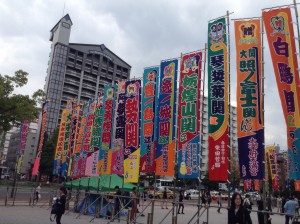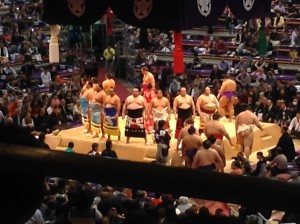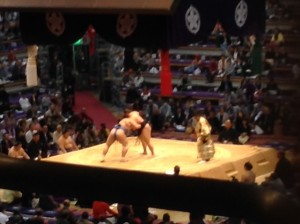春休みが始まった際に僕は友達と一緒に相撲試合を見に行こうと思っていました。僕の友達の住んでいる寮の管理人さんは仲間がいいし、相撲のルールが知っているし、相撲の切符を安く買えたので、彼を誘いました。行く途中で東長寺に立ち寄りました。余暇があったので、川の近くの腰掛で座って、喋りました。相撲の講堂で、あつく甘いナッツが売れましたが、高かったですから、買いませんでした。天井桟敷で座っても、視界は大丈夫でした。天井桟敷の席の基本料金は¥2000(GBP10)です。最高の席の値段は¥1500(GBP120)以下です。
管理人さんは以前に相撲を見たことがあったかのように相撲のことを知っていました。相撲は日本の伝統的なスポーツです。相撲力士は四股名を作り上げます。試合は二週間かかりますが、一日に一回だけ喧嘩できます。喧嘩を見るのは本当に楽しいです。
先ず、力士が入るとき、行司の周辺に円陣を作ります。次に喧嘩する力士は土俵に入って、米を抛って、相手を睨みます。鮟鱇形が多かったです。外人の相撲取りもいっても、日本からの四股名がありました。もし、日本に行く機会があったら、是非、相撲試合に見に行くべきだと思います。本当に胸躍りますよ。皆さんは相撲が落とすのを見るのが大好きです。
相撲の目的は丸の外に相手を移し、相手の手や頭部など床を触らせます。押せ、引け、回しを掴め、投げます。しかし、打てません。相撲は太るために、ちゃんこ鍋を食べています。
My friend and I were thinking to go and see a sumo match to start off our spring break. My friend is good pals with the manager in his dormitory so he invited him along too. He knew more about sumo than we did and knew how to get the tickets cheaply and is actually a really nice guy. The manager guy made his own way to the arena and me and my friend went by train. We arrived a bit early so we took a look around this super cool temple in Hakata called ‘Touchouji’. We reached the meeting place and had a bit of spare time so we sat by the marina behind the arena and watched the boats and chatted for a while. We met our guy and went inside, they were selling cups of hot, sweet nuts inside the auditorium but they were too expensive.
Even though we had the cheap-seats, the view was pretty good and you see quite a lot. The only bad point is that it’s quite hard to take a good photo as we were very far away. Our seats cost about £10 and the ring-side seats cost as much as £120. The ringside seats are very close to the sumo stage and often spectators can be crushed by the wrestlers if they get forced out of the sumo circle. The stage is about 6 steps up from the ringside seat level so is quite a big drop; and everyone loves seeing the loser fall off of the platform for a most spectacular fight.
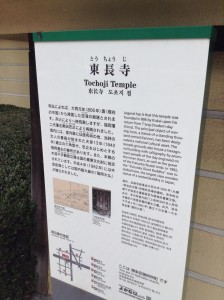 Competitions last for two-weeks and each wrestler fights once a day. Sumo wrestlers always fight under a different name which is given to them by their stable master, wrestlers usually have no choice in the name assigned to them. As the fighters enter, they all form a circle around the referee. Next, everyone leaves the ring and the two contending fighters enter. They throw rice into the crowd, wipe the sweat off their face and stare down their opponent.
Competitions last for two-weeks and each wrestler fights once a day. Sumo wrestlers always fight under a different name which is given to them by their stable master, wrestlers usually have no choice in the name assigned to them. As the fighters enter, they all form a circle around the referee. Next, everyone leaves the ring and the two contending fighters enter. They throw rice into the crowd, wipe the sweat off their face and stare down their opponent.
The aim of the match is to force your opponent outside the circle, or to force them to touch the floor. Any body part other than the feet touching the floor counts as a loss. Wrestlers can push, pull, grab the mawashi (belt) and throw. No striking allowed. The fatter the wrestler, the harder the fight and the more entertaining the round is. The staple meal sumo wrestlers eat to maintain their body weight is Chanko nabe. Chanko nabe is a one pot dish with stock made from dashi or mirin, and is made with quartered chicken thighs (with skin on), tofu, enoki mushrooms; and is really tasty.
If you ever get the opportunity to visit Japan, a sumo fight is a must-see!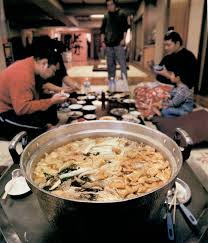
Chanko nabe is a kind of stew that’s known as the original sumo food. Despite the reputation that sumos have for their huge statures, the recipe for chanko nabe is actually relatively healthy, low in fat and loaded with vegetables. This version uses only chicken – based on the old joke that eating an animal that walks only on two legs will help a sumo stay on his feet – but in reality there’s no fixed recipe for chanko nabe, and versions can contain beef, salmon, pork or anything else you like. In fact, the only qualification for something to be chanko nabe seems to be that it is made by, or for, a sumo

